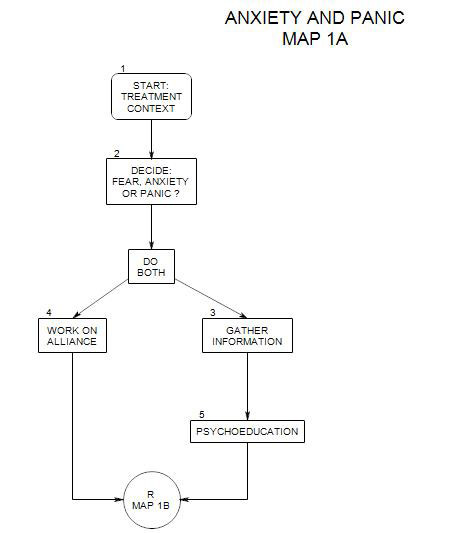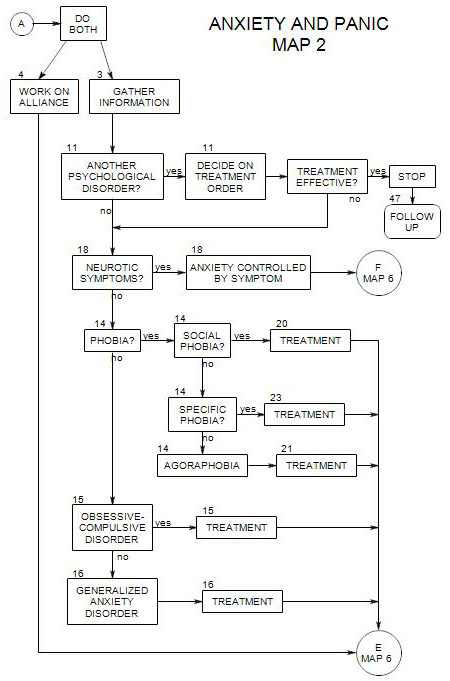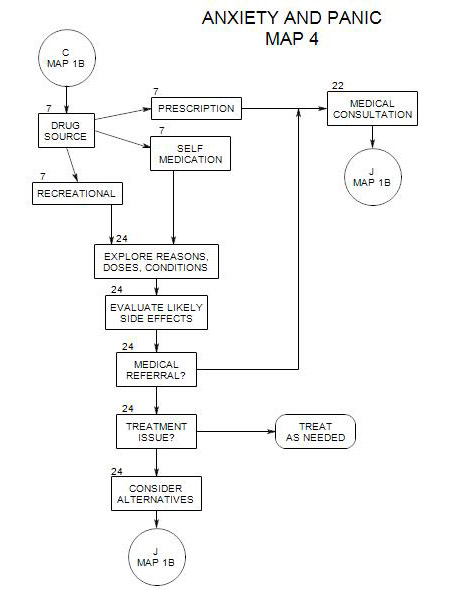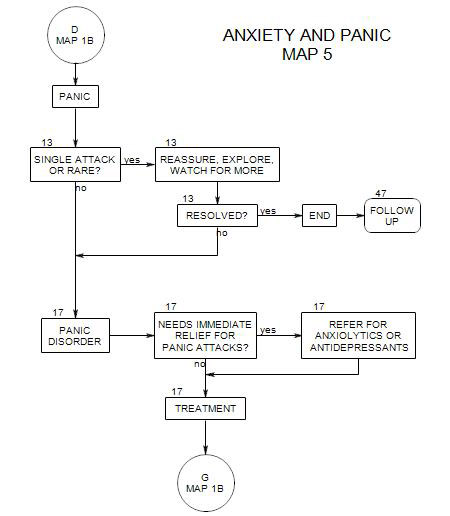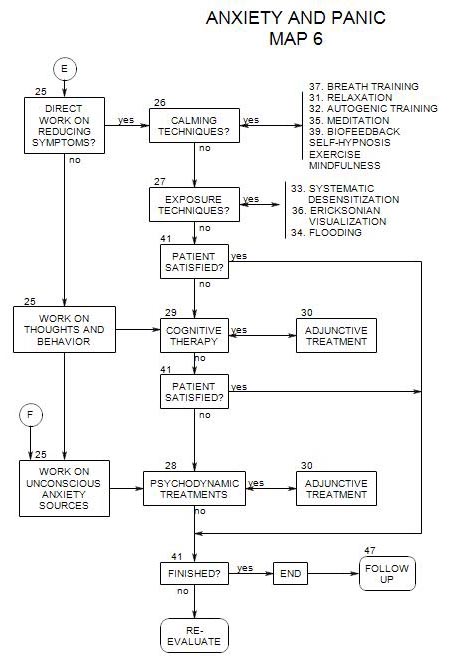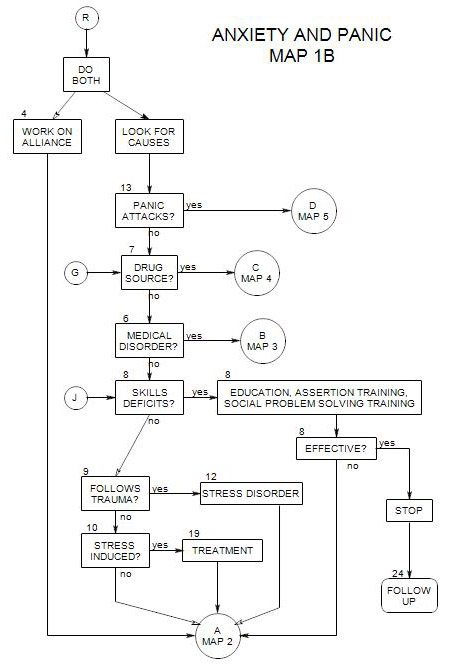
SECTIONS: 4 | 6 | 7 | 8 | 9 | 10 | 12 | 13 | 19 | 24
- Follows Section 14 on Map 2
Specific or simple phobias are fears about specific situations, activities or objects. Typically the person is afraid of some imagined consequence from contact with the feared object or circumstance, and not about the fear symptoms. This simplifies treatment.
However, few people come for treatment for a single phobia. Usually they have a variety of other symptoms, and it is difficult to decide whether to treat the phobia by itself or in some larger context. (Barlow, 1988, PP. 475, 485)
It can be helpful to gather information about the feared object or situation and the person’s reactions to it, by asking him/her to keep a record of encounters between therapy sessions. This should be recorded as soon after the experience as possible, and include information about-
- the situation.
- the trigger.
- the person’s thoughts and feelings during the event.
- the person’s behavior in reaction to it.
23a. Choice of Treatment
It may be helpful to determine the source of the phobia– whether it came through direct experience with the feared object or situation or through misinformation (Barlow, 1988, pp. 488-489). If it came through direct experience, such as being attacked by a dog, then exposure techniques [Section 27] would probably be most helpful.
On the other hand, if the source of the phobia is through misinformation, there is evidence that cognitive correction may be helpful. Presumably this would involve cognitive treatment if the person is aware of the source of the information and dynamic therapy if he/she is not aware of it.
In general, the consensus appears to be that exposure techniques are the mainstay of treatment for a simple phobia, and that cognitive and psychodynamic therapies are best considered adjunctive. Cognitive therapy may be valuable in dealing with cognitive distortions in preparation for extinction work, and dynamic therapy may be necessary if extinction fails or the phobia is found to be part of a disorder involving wide-ranging associations or unconscious roots.
Exposure
When exposure is used, treatment typically involves in vivo desensitization [Section 33], with distance or intensity as the variable modified [Barlow, 486].
- Distance: for fear of insects, you can arrange for the person to approach the insect slowly until it is actually crawling on the person’s skin.
- Intensity: for fear of thunderstorms, a thunderstorm is simulated at increasing intensities.
A combination of imaginal and in vivo exposure can work for some fears, for example, fear of cats. Desensitization might involve presenting drawings or photographs of cats at a distance and over time reducing the distance. When the person is able to handle the photographs, begin extinction through fantasy encounters. Finally, work on exposure to a real cat, again starting at a distance and gradually reducing the distance until the person is holding and petting the animal.
Failure of Exposure
Barlow [485-486] suggests that you take notice if the attempt to extinguish a simple phobia is consistently ineffective. It may be that the phobia is itself a symptom of another disorder. In one example, a patient’s fear of knives derived from her fear that she would use one to kill her own grandchildren. In another, a patient’s fear of shopping derived from her difficulty making decisions, part of a major depressive episode. In this case, you may need to change therapeutic approaches [].
23b. Adjunctive Treatments
Cognitive Therapy
It is not clear whether cognitive therapy can be sufficient for treatment of a phobia with origins in misinformation or cognitive distortions, although it might be worth trying, especially if it is your preferred approach.
Even if cognitive treatment isn’t sufficient to remove the phobia, it could still be valuable to deal with thought distortions prior to exposure work.
You should be alert for a need to move to exposure techniques, as well as the possibility of unconscious underpinnings of the phobia that might benefit from a dynamic approach.
Dynamic Therapy
This is generally not considered an effective adjunctive approach to exposure techniques in this case. However, it may be the general approach you are using when the need for treatment of a phobia arises. It may also be a follow-up treatment approach, when exposure fails to extinguish the phobia or if related issues surface during exposure trials [See Section 28 for dynamic therapy or for choices]..
Typically a dynamic therapist would be looking for broader personality issues, with the phobia seen as a symptom having specific meaning that needs to be uncovered. At the same time, (Mineka and Zinbarg, 2006, pp. 11-14) some other issues may become a focus of therapeutic attention, including –
- a possibility of vicarious conditioning, through watching someone else face the feared situation – in life or even on television. “What have you seen or heard that might be related to this?”
- early childhood shyness.
- a history of traumatic encounters – especially if inescapable.
- lack of sense of mastery or control over one’s own life.
- getting information suggesting that the precipitating event was more dangerous than initially experienced.
Autogenic training [Section 32] can be helpful in dealing with anticipatory anxiety, which drives a person’s avoidance behaviors (Linden and Lenz, 1997, p. 145), and by helping a person recover more rapidly after exposure to a feared object or situation. Otherwise, the exposure can have effects that persist for hours or days. [Linden and Lenz, p. 145]
Medication is seldom recommended, both because psychological treatments are usually sufficient [Mavissakalian and Ryan, 1997, p. 176], and because there appears to be no benefit from adding medication to the treatment regimen (Barlow, 1988, p. 490)
23c. Formal Diagnosis: Use 300.29 from the DSM
